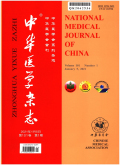血小板/淋巴细胞比值与糖尿病合并维持性血液透析患者认知功能障碍的相关性
Relationship between platelet/lymphocyte ratio and cognitive impairment in diabetic patients treated with maintenance hemodialysis
摘要目的:探讨血小板/淋巴细胞比值(PLR)与糖尿病合并维持性血液透析(MHD)患者认知功能障碍的关系。方法:收集2019年5至8月贵州省18家血液透析中心糖尿病合并MHD患者的年龄、性别、基础疾病、用药史等一般资料,生化指标及简易智力状态检查量表(MMSE)评分,根据是否发生认知功能障碍分为认知功能障碍组和认知功能正常组,根据PLR四分位数将所有研究对象分为4组,即PLR Q1、Q2、Q3、Q4组,比较各组之间临床特征的差异;采用多因素logistic回归分析评估PLR水平与糖尿病合并MHD患者认知功能障碍之间的关系;采用受试者工作特征(ROC)曲线分析PLR对糖尿病合并MHD患者认知功能障碍的评估价值。结果:共纳入586例患者,男389例(66.4%),年龄(63±11)岁,认知功能障碍341例,患病率为58.2%。多因素logistic回归分析结果提示PLR与糖尿病合并MHD患者认知功能障碍有关,PLR Q4组糖尿病合并MHD患者认知功能障碍风险为Q1组的3.022倍(95% CI:1.866~4.895, P<0.001);校正性别、年龄、透析龄、文化程度后,PLR Q4组患者认知功能障碍风险为Q1组的2.529倍(95% CI:1.536~4.164, P<0.001);进一步校正血红蛋白、白蛋白、血肌酐、白细胞、空腹血糖后,PLR Q4组患者认知功能障碍风险为Q1组的2.281倍(95% CI:1.203~4.326, P=0.012)。ROC曲线分析结果提示,PLR评估糖尿病合并MHD患者认知功能障碍的最佳阈值为155.3,灵敏度、特异度分别为57.2%、60.8%,曲线下面积为0.608(95% CI:0.561~0.644, P<0.001)。 结论:PLR与糖尿病合并MHD患者认知功能障碍有关。
更多相关知识
abstractsObjective:To explore the relationship between platelet/lymphocyte ratio (PLR) and cognitive impairment (CI) in diabetic patients treated with maintenance hemodialysis (MHD).Methods:The data of age, gender, underlying diseases, medication history, mini-mental state examination (MMSE) and biochemical indexes of diabetic MHD patients who were treated in 18 hemodialysis center in Guizhou Province between May and August 2019 were collected. According to whether they had CI or not, the patients were divided into CI group and control group, and the clinical characteristics between the two groups were compared. In addition, the patients were divided into four groups according to the quartile of PLR (PLR Q1, Q2, Q3 and Q4 group). Multivariate logistic regression models were used to analyze the relationship between PLR level and CI in diabetic MHD patients. The receiver operating characteristic (ROC) curve was used to evaluate the diagnostic value of PLR in detecting CI in diabetic MHD patients.Results:Totally, 586 diabetic MHD patients (389 males) were included, with a mean age of (63±11) years. Multivariate logistic regression analysis showed that PLR was associated with the risk of CI in diabetic MHD patients, and the risk of CI in PLR Q4 group was 3.022 times of that of PLR Q1 Group (95% CI: 1.866-4.895, P<0.001). After adjusting for gender, age, dialysis age and education level, the risk of CI in PLR Q4 group was 2.529 times of that in PLR Q1 Group (95% CI: 1.536-4.164, P<0.001). After further adjusting for hemoglobin, albumin, creatinine, leukocyte and blood glucose, the risk of CI in PLR Q4 group was 2.281 times of that in PLR Q1 group (95% CI: 1.203-4.326, P=0.012). ROC curve analysis showed that the optimal threshold for PLR to predict CI in diabetic MHD patients was 155.3, with a sensitivity of 57.2% and a specificity of 60.8%, and the area under the curve was 0.608 (95% CI: 0.561-0.644, P<0.001). Conclusion:PLR is associated with CI in diabetic MHD patients.
More相关知识
- 浏览325
- 被引12
- 下载515


相似文献
- 中文期刊
- 外文期刊
- 学位论文
- 会议论文



 换一批
换一批 换一批
换一批



